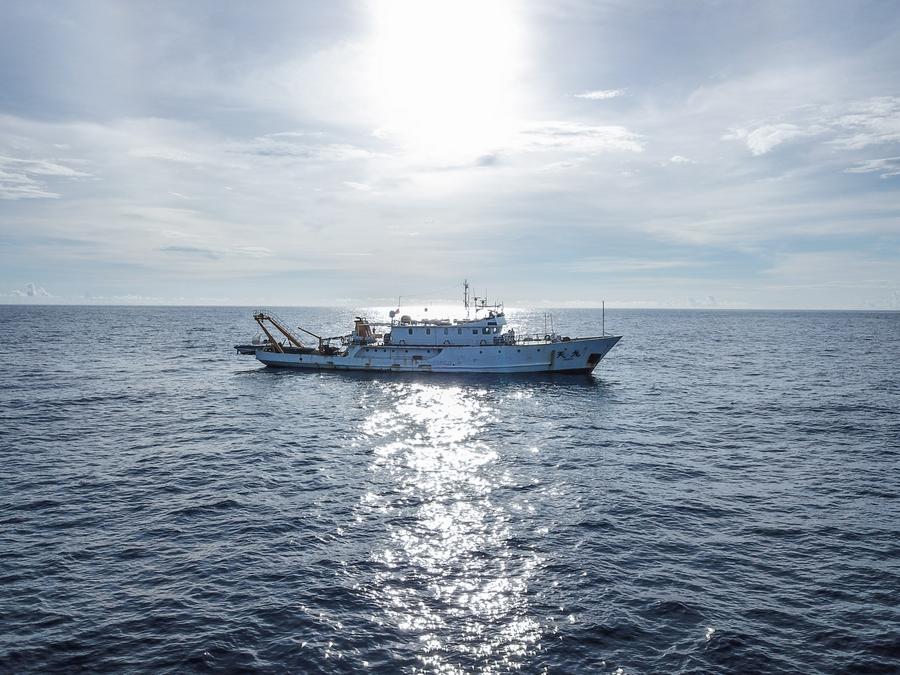BEIJING, Feb. 2 (Xinhua) -- Some waters of the South China Sea have not been calm over the past couple of months, as the Philippines has been stirring up troubles through provocative acts one after another targeting China's Ren'ai Jiao and Huangyan Dao in the South China Sea. On Dec. 10, 2023, Philippine vessels intruded into adjacent waters of Ren'ai Jiao in China's Nansha Qundao in an attempt to illegally ship construction materials to its warship deliberately "grounded" at the reef in 1999. The Philippines has explicitly promised to tow away the military vessel, however, in the 24 years since, the Philippines has sought to repair and reinforce it to permanently occupy Ren'ai Jiao. On Jan. 28, four Philippine personnel illegally broke into the reef plate of Huangyan Dao, and the China Coast Guard warned and drove them away in a law-based and professional way. What the Philippine side has done, in collusion with some countries outside the region, has seriously infringed China's sovereignty, soured bilateral relations, and raised tensions in the South China Sea. The actions also contravene international law and the Declaration on the Conduct of Parties in the South China Sea (DOC). Such provocations are not only unwise but futile. China's Nanhai Zhudao (the South China Sea Islands) consist of Dongsha Qundao (the Dongsha Islands), Xisha Qundao (the Xisha Islands), Zhongsha Qundao (the Zhongsha Islands) and Nansha Qundao (the Nansha Islands). These Islands include, among others, islands, reefs, shoals and cays of various numbers and sizes. The activities of the Chinese people in the South China Sea date back to over 2,000 years ago. China is the first to have discovered, named, and explored and exploited Nanhai Zhudao and relevant waters, and the first to have continuously, peacefully and effectively exercised sovereignty and jurisdiction over them. China's sovereignty over Nanhai Zhudao and relevant rights and interests in the South China Sea have been established in the long course of history, and are solidly grounded in history and law. Peace and stability in the South China Sea is vital to the security, development and prosperity of the countries and people of the region. The realization of peace, stability, prosperity and development in the South China Sea region is the shared aspiration and responsibility of China and ASEAN member states. China adheres to the position of settling disputes through negotiation and consultation and managing differences through rules and mechanisms, and remains committed to making the South China Sea a sea of peace, cooperation and friendship. But China also stands firm in safeguarding its territorial sovereignty and maritime rights and interests. Historical facts regarding China's sovereignty over Nanhai Zhudao must be respected. Common understandings should be binding and commitments must be honored. China's goodwill, sincerity and restraint cannot be exploited without limits. To maintain stability in the South China Sea, all parties must follow the "dual-track approach," namely, maritime disputes should be handled properly by countries directly concerned through dialogue and consultation, and peace and stability in the South China Sea should be jointly safeguarded by China and ASEAN countries. Attempts to court external forces or create a small bloc in the region to pressure China will do nothing to manage differences. For peace and stability in the South China Sea, it would be wise for the Philippine side to change track and return to the right path of dialogue and consultation to resolve the maritime differences between the two countries.
Provocations by the Philippines in South China Sea unwise, futile
Editor:谭婕倪
Source:Xinhua
Updated:2024-02-03 17:26:05
Source:Xinhua
Updated:2024-02-03 17:26:05
Special
Contact
Welcome to English Channel! Any suggestion, welcome.Tel:0731-82965627
lisl@rednet.cn
zhouqian@rednet.cn











